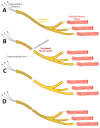The Role of Biomaterials in Peripheral Nerve and Spinal Cord Injury: A Review
- PMID: 35163168
- PMCID: PMC8835501
- DOI: 10.3390/ijms23031244
The Role of Biomaterials in Peripheral Nerve and Spinal Cord Injury: A Review
Abstract
Peripheral nerve and spinal cord injuries are potentially devastating traumatic conditions with major consequences for patients' lives. Severe cases of these conditions are currently incurable. In both the peripheral nerves and the spinal cord, disruption and degeneration of axons is the main cause of neurological deficits. Biomaterials offer experimental solutions to improve these conditions. They can be engineered as scaffolds that mimic the nerve tissue extracellular matrix and, upon implantation, encourage axonal regeneration. Furthermore, biomaterial scaffolds can be designed to deliver therapeutic agents to the lesion site. This article presents the principles and recent advances in the use of biomaterials for axonal regeneration and nervous system repair.
Keywords: biomaterials; peripheral nerve injury; spinal cord injury.
Conflict of interest statement
The authors declare no conflict of interest. The funders had no role in the design of the study; in the collection, analyses, or interpretation of data; in the writing of the manuscript, or in the decision to publish the results.
Figures





References
Publication types
MeSH terms
Substances
LinkOut - more resources
Full Text Sources
Medical

